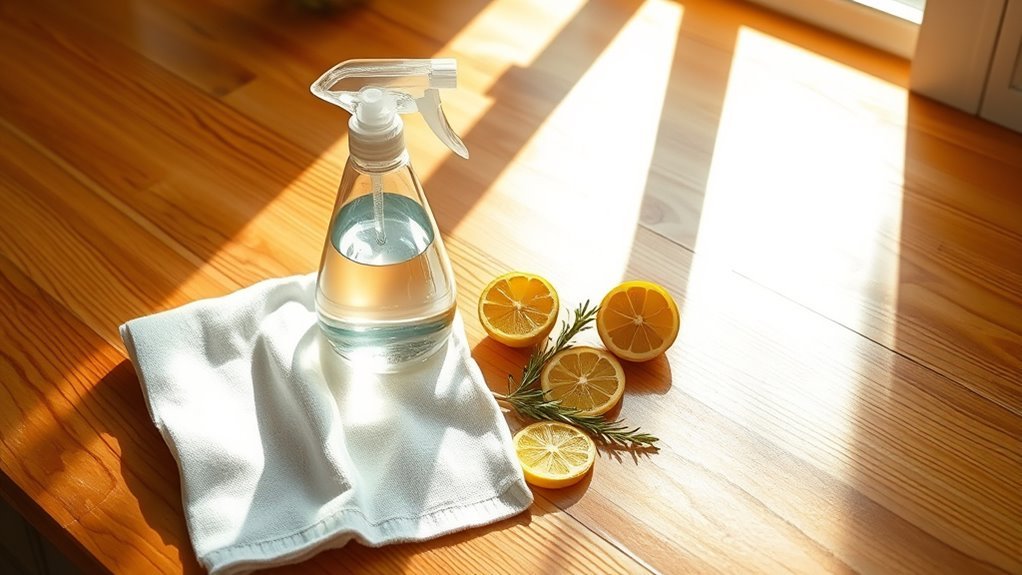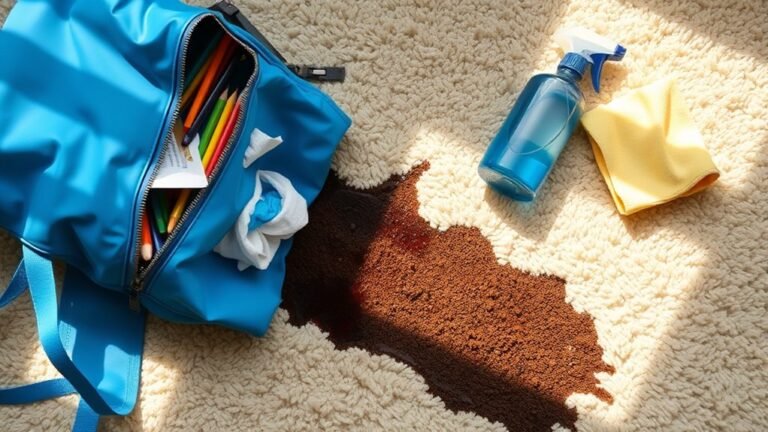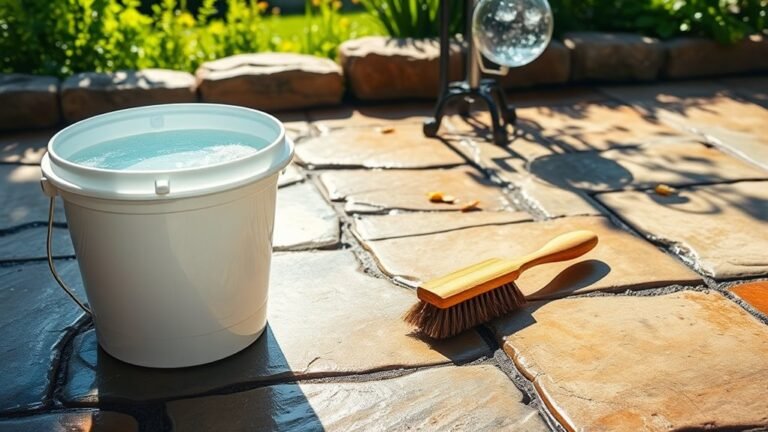DIY Cleaner for Wood Surfaces
You can make a gentle, effective DIY wood cleaner by mixing one cup of warm water, half a cup of white vinegar, and two tablespoons of olive oil. This combo cleans grime, nourishes wood, and adds a protective shine without harsh chemicals. Just spray lightly, wipe with a soft cloth following the grain, and avoid soaking. Use baking soda or vinegar for tough stains. For more tips on safe use and maintenance, keep exploring these easy wood care solutions.
Essential Ingredients for Homemade Wood Cleaners
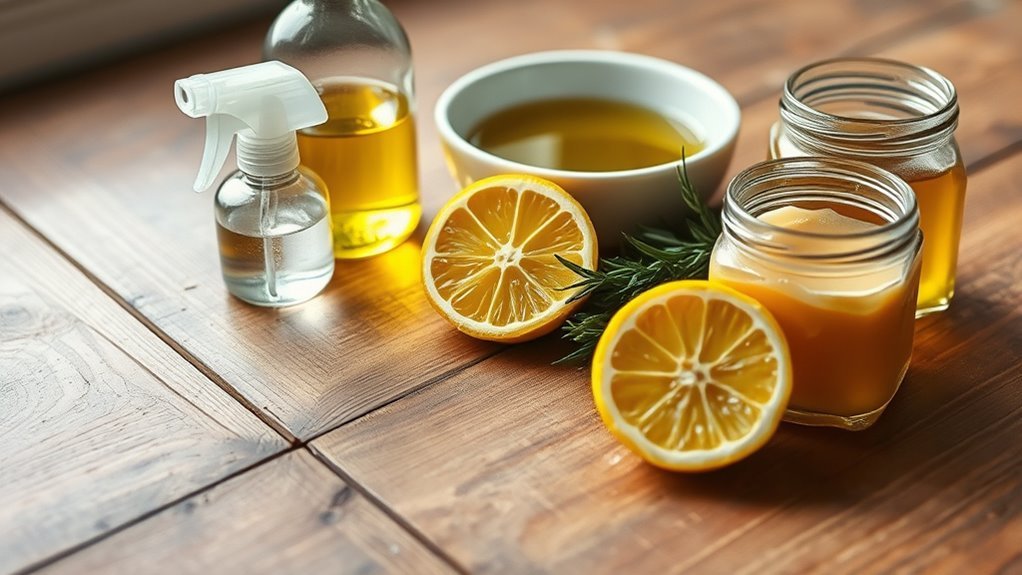
When making your own wood cleaner, you’ll want to focus on a few key ingredients that are both effective and safe for wood surfaces. Vinegar benefits are well-known—it gently cuts through grime without damaging the finish, making it a perfect natural choice. Pairing vinegar with the right oil types, like lemon or mineral oil, helps nourish and protect the wood, restoring its natural shine and preventing drying. These oils also create a barrier that repels dust and moisture, extending the life of your wood. By choosing these simple, natural ingredients, you gain freedom from harsh chemicals and costly commercial products. This approach lets you confidently care for your wood surfaces while knowing exactly what’s in your cleaner.
Step-by-Step Guide to Making a Basic Wood Surface Cleaner
Creating your own wood surface cleaner is simpler than you might think. Start by mixing one cup of warm water with half a cup of white vinegar and two tablespoons of olive oil. This blend balances cleaning techniques with wood care, gently lifting dirt while nourishing the surface. Pour the solution into a spray bottle for easy use. Before applying, test a small area to verify no damage occurs. Spray lightly on your wood surface and wipe with a soft cloth, moving with the grain to protect the finish. This DIY cleaner gives you control over what touches your wood, freeing you from harsh chemicals and expensive products. Embrace this straightforward approach to keep your wood surfaces clean, vibrant, and well-cared for.
Natural Alternatives for Tough Wood Stains
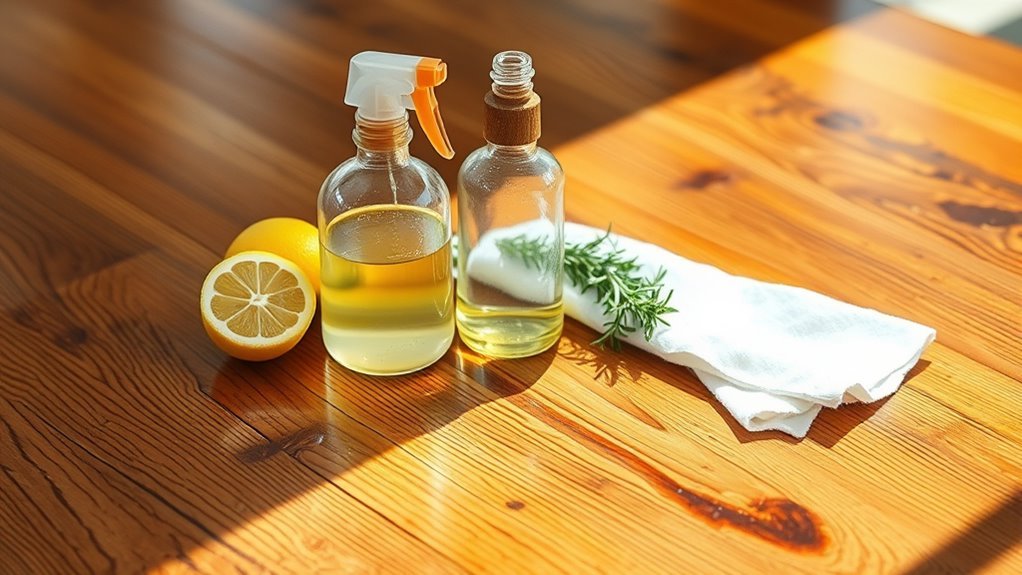
Although tough wood stains can be stubborn, you don’t have to rely on harsh chemicals to remove them. Natural alternatives like the baking soda remedy and vinegar solution offer effective, eco-friendly options that you can make at home. These solutions respect your freedom to clean safely and sustainably.
| Stain Type | Baking Soda Remedy | Vinegar Solution |
|---|---|---|
| Grease | Mix baking soda with water | Vinegar diluted with water |
| Ink | Paste of baking soda & water | Full-strength vinegar |
| Coffee/Tea | Baking soda scrub | Vinegar spray |
| Pet stains | Baking soda sprinkle | Vinegar and water mix |
Try these natural remedies to restore your wood’s beauty without compromising your values.
Tips for Applying DIY Cleaners Safely on Wood
Since wood is a delicate material, you’ll want to apply DIY cleaners carefully to avoid damage. Start by selecting the right cleaning equipment—soft cloths or sponges work best to protect wood finishes without scratching. Avoid abrasive tools that can strip or dull the surface. Always test your cleaner on a small, hidden area first to verify it won’t harm the finish. When applying, use gentle, circular motions and avoid soaking the wood; excess moisture can warp or stain. Work in a well-ventilated space to keep your freedom intact and avoid inhaling fumes. Finally, wipe off any residue promptly to maintain the wood’s natural beauty. With these simple tips, you can safely clean your wood surfaces and enjoy their lasting charm.
How to Maintain Wood Surfaces Between Cleanings

A key part of keeping your wood surfaces looking great between cleanings is regular maintenance. Sticking to a simple wood care maintenance routine guarantees your surfaces stay protected and vibrant without restricting your freedom to enjoy them. Here’s a quick guide to help you maintain your wood surfaces effortlessly:
| Task | Frequency | Tips |
|---|---|---|
| Dusting | Weekly | Use a soft, dry cloth |
| Wiping spills | Immediately | Use a damp cloth, dry quickly |
| Applying polish | Monthly | Choose natural oils |
| Checking for damage | Quarterly | Look for scratches or cracks |
| Conditioning | Twice a year | Use a quality wood conditioner |
Common Mistakes to Avoid When Cleaning Wood
Maintaining your wood surfaces regularly helps keep them in great shape, but how you clean them matters just as much. One common mistake is ignoring cleaning frequency—overdoing it can strip natural oils, while under-cleaning lets dirt build up, dulling the finish. Also, don’t assume all products are safe; always check product compatibility with your wood type. Harsh chemicals or abrasive cleaners can cause irreversible damage. Another pitfall is using too much water; wood hates excess moisture, which can warp or stain. Finally, avoid scrubbing aggressively; gentle wiping preserves the surface’s integrity. By steering clear of these errors, you’ll enjoy wood that stays beautiful and free, reflecting your care without unnecessary restrictions or damage.
Frequently Asked Questions
Can DIY Wood Cleaners Damage Antique or Delicate Wood Finishes?
You might think DIY wood cleaners are safe, but they can sometimes damage antique wood or delicate finishes if you’re not careful. These finishes are often sensitive to harsh ingredients or strong acids found in homemade solutions. To keep your freedom to clean without worry, test any cleaner on a small, hidden spot first. That way, you protect your wood’s beauty while still enjoying the satisfaction of doing it yourself.
How Often Should I Deep Clean Wood Surfaces With Homemade Cleaners?
Think of your wood surfaces like a garden—too frequent deep cleaning can be like overwatering, causing damage instead of growth. Your cleaning frequency should depend on surface types; delicate or antique woods need less frequent, gentle care, maybe every few months. More durable woods can handle monthly deep cleans. By tuning into your surfaces’ needs, you keep them vibrant without feeling trapped by constant maintenance, letting your space breathe freely.
Are DIY Wood Cleaners Safe for Outdoor Wooden Furniture?
You can definitely use DIY wood cleaners for outdoor wooden furniture, but you’ll want to take into account outdoor exposure when choosing ingredients. Natural cleaners like vinegar and mild soap are safe and gentle, helping preserve the wood without harsh chemicals. Since outdoor furniture faces more dirt and weather, adjusting your cleaning frequency is key—cleaning every few weeks or after heavy exposure keeps your pieces looking great and protected while giving you the freedom to customize your routine.
Can I Use Essential Oils in My Homemade Wood Cleaner?
You might wonder if essential oils can enhance your homemade wood cleaner. They actually bring benefits like natural antibacterial properties and a pleasant scent, making your cleaner more effective and enjoyable. Many wood cleaner recipes include oils like lemon or tea tree for their cleansing power. Just be sure to dilute them properly, so your wood stays safe and you get that fresh, freeing feeling while caring for your surfaces.
How Do I Store Homemade Wood Cleaners to Keep Them Effective?
To keep your homemade wood cleaner effective, store it in airtight storage containers to prevent exposure to air and moisture, which can shorten its shelf life. Choose dark glass bottles if possible, as they protect against light that can degrade ingredients. Keep the containers in a cool, dark place away from heat sources. By doing this, you’ll maintain the cleaner’s potency and enjoy freedom from frequent remaking.
